
Should kids act to stop bullying, or should they leave it up to adults?
- Subject:
- English Language Arts
- Material Type:
- Homework/Assignment
- Author:
- Kristin Robinson
- Date Added:
- 02/12/2020

Should kids act to stop bullying, or should they leave it up to adults?

In this problem-based learning module, students will be asked to brainstorm ideas and think innovatively both independently and collaboratively in addressing a real-world problem that is relevant to their daily lives and health. Are students aware of their calorie intake and how it affects their overall health? Students will investigate the calories consumed in a typical day and how much physical activity is needed to stay healthy and fit. Students/teams will be encouraged to use the internet for research purposes in their design phase. Students will utilize various online platforms to design an infographic that can be shared with relevant individuals in the community and others in the school building

The ability to identify prepositional phrases strengthens a writer's ability to write and punctuate complete, grammatically sound sentences.This plan has been created by Cherie J. Johnson for the purpose of helping middle school students on their way to becoming clean, clear, fluent writers. This material was put together while participating in the workshop- Nebraska’s OER Common’s Hub for ELA & Reading; July 22-24, 2020.
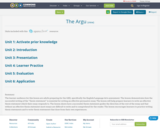
The learner-audience for this lesson are adults preparing for the GED, specifically the English/Language Arts assessment. The lesson demonstrates how the successful writing of the “thesis-statement” is essential for writing an effective persuasive essay. The lesson will help prepare learners to write an effective thesis statement which their essay responds to. The lesson shows how a successful thesis statement guides the direction of the rest of the essay and that without an effective thesis statement most essays are difficult to write and to comprehend for the reader. The lesson encourages learners to practice writing thesis statements and to write thesis statements that draw from their own experiences.
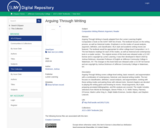
Abstract
Arguing Through Writing is heavily adapted from the Lumen Learning English Composition 2 book on the SUNY OER list of texts. The textbook focuses on the writing process, as well as rhetorical modes. Emphasis is on the modes of causal analysis, argument, definition, and classification. MLA style and academic writing moves are featured. The textbook would be appropriate for either college-level Composition 1 or 2. The text features readings for each of the modes, as well as historical and contemporary texts in a reader section. The original version of this book was released under a CC-BY license and is copyright by Lumen Learning. It was then developed in March 2020 by Joshua Dickinson, Associate Professor of English at Jefferson Community College in Watertown, NY. The changes to this book listed are released under a CC-BY-SA license and are copyright by Joshua Dickinson of Jefferson Community College in Watertown, NY.
Description
Arguing Through Writing covers college-level writing, basic research, and argumentation with a combination of contemporary, historical, and classical writing models. The text focuses on classification, definition, causal analysis, and argumentation, working with these writing modes and pairing those with relevant texts. Several chapters are devoted to playing the writing game and knowing its moves. Visual arguments, MLA style, preparing annotated bibliographies, and film analysis are covered. The reader includes selections from Michel de Montaigne, Steven Pinker, H. G. Wells' history, Flannery O'Connor, Martin Luther King Jr., Ralph Waldo Emerson, Gordon Allport, and Stephen Leacock.
URI
http://hdl.handle.net/1951/71291

Argument is a familiar concept to most people; however, to win an argument, or at least, to argue points effectively is not so easy. In this seminar, you will learn the basic concepts surrounding argument and, in turn, develop an argument utilizing components that set you up for success. Remember, argument does not mean yelling at someone because you think you’re right; argument refers to logical thinking with clear points, building toward a specific outcome.StandardsCC.1.2.9-10.H: Delineate and evaluate the argument and specific claims in a text, assessing the validity of reasoning and relevance of evidence.CC.1.4.9-10.C: Develop and analyze the topic with relevant, well-chosen, and sufficient facts, extended definitions, concrete details, quotations, or other information and examples appropriate to the audience’s knowledge of the topic; include graphics and multimedia when useful to aiding comprehension.CC.1.4.9-10.G: Write arguments to support claims in an analysis of substantive topics.

Argument is a familiar concept to most people; however, to win an argument, or at least, to argue points effectively is not so easy. In this seminar, you will learn the basic concepts surrounding argument and, in turn, develop an argument utilizing components that set you up for success. Remember, argument does not mean yelling at someone because you think you’re right; argument refers to logical thinking with clear points, building toward a specific outcome.StandardsCC.1.2.9-10.H: Delineate and evaluate the argument and specific claims in a text, assessing the validity of reasoning and relevance of evidence.CC.1.4.9-10.C: Develop and analyze the topic with relevant, well-chosen, and sufficient facts, extended definitions, concrete details, quotations, or other information and examples appropriate to the audience’s knowledge of the topic; include graphics and multimedia when useful to aiding comprehension.CC.1.4.9-10.G: Write arguments to support claims in an analysis of substantive topics.
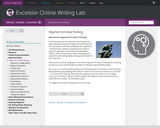
In this learning area, you will learn how to develop an argumentative essay and stronger critical thinking skills. This learning area will help you develop your arguments, understand your audience, evaluate source material, approach arguments rhetorically, and avoid logical fallacies. Here, you’ll also learn about evaluating other arguments and creating digital writing projects related to your argument.

This resource is useful for some general information about argument essays and how to organize them.

Basic purpose and organization of a five-paragraph, argument essay. Audience: Community College Transitional English Instructors.

Students analyze World War II posters, as a group and then independently, to explore how argument, persuasion and propaganda differ.
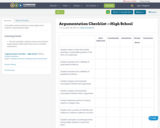
A checklist used by teachers to assess high school students’ argumentation skills.
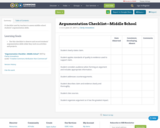
A checklist used by teachers to assess middle school students’ argumentation skills.
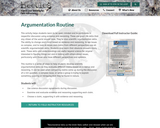
This activity helps students learn to be open-minded and to participate in respectful discussion using evidence and reasoning. These are great life skills that any citizen of the world should have. They’re also scientific argumentation skills. The ability to change one’s mind based on evidence and reasoning, to see issues as complex, and to look at issues and claims from different perspectives are all scientific argumentation skills. Students also learn that absolute answers rarely exist. These skills and understandings are useful beyond science for anyone interested in figuring things out and in talking with others about issues, particularly with those who have different perspectives and opinions.
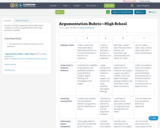
A rubric in student language used by high school students to create an argument that meets high standards of quality.
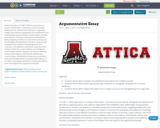
Indiana Standard:
9-10.W.3.1 Write arguments in a variety of forms that – ● Introduce precise claim(s), distinguish the claim(s) from alternate or opposing claims, and create an organization that establishes clear relationships among claim(s), counterclaims, reasons, and evidence. ● Develop claim(s) and counterclaims fairly, supplying evidence for each while pointing out the strengths and limitations of both in a manner that anticipates the audience’s knowledge level and concerns. ● Use effective transitions to link the major sections of the text, create cohesion, and clarify the relationships between claim(s) and reasons, between reasons and evidence, and between claim(s) and counterclaims. ● Establish and maintain a consistent style and tone appropriate to purpose and audience. ● Provide a concluding statement or section that follows from and supports the argument presented.

Explanation and overview of the argumentative or persuasive essay. 9-minute video.
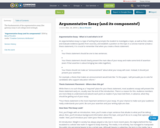
The fundamentals of the argumentative essay (the gateway essay to all college level writing!).
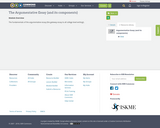
The fundamentals of the argumentative essay (the gateway essay to all college level writing!).

This module provides instructions on how to write an argumentative research paper.